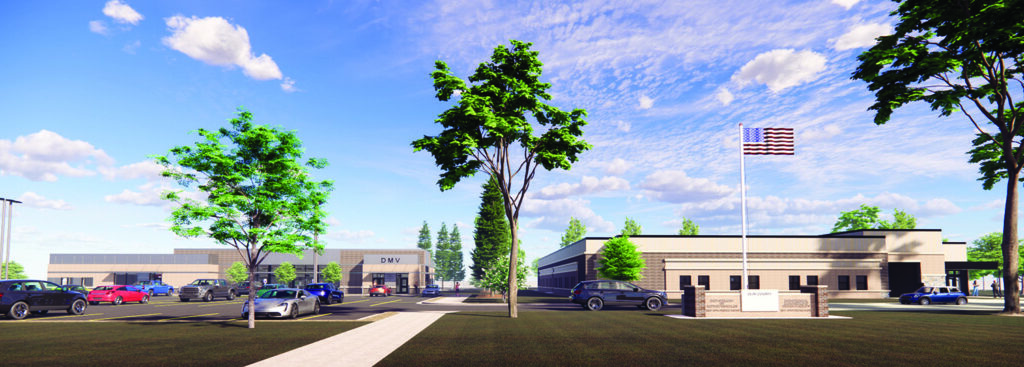
Architect’s rendering of DMV and Substance Management Facility, both under construction on 15th Avenue North.
Nancy Edmonds Hanson
You’ll be renewing your driver’s licenses and buying vehicle tabs – and perhaps taking drivers’ tests — in a brand new spot by this time next year.
Construction has begun on the Clay County Department of Motor Vehicles’ next location in north Moorhead. Earth movers began site preparation last week along 15th Avenue North west of 34th Street – just a couple of miles east of where the DMV had stood for years before moving into an unoccupied storefront in the Center Mall three years ago.
Neither that move nor the one now underway was by choice, Clay County administrator Steve Larson points out. But when the project on 15th Avenue is ultimately complete, residents are likely to find it remedies the shortcomings that have sometimes frustrated applicants in years gone by.
There’s Covid-19 to thank for the years-long game of musical chairs. “Our old DMV building was very small – about 700 square feet,” Larson explains. “When the pandemic came along in March 2020 with the requirement for social distancing, we had a real problem. The DMV is a busy place. The lot was full by 7:45 every morning. Unless you were first, you could have to sit in your car for 45 minutes to an hour.”
That was remedied in November 2020, when the county office reopened in the Center Mall in a vacant site formerly occupied by a furniture store. Clay County worked out a three-year lease agreement with the option to extend it two more years. The location has proven popular with residents, offering plenty of space in an easily reached downtown location. At the same time, the state of Minnesota adopted a new computer records system that was far more user friendly, ironing out another lingering frustration.
But the redevelopment of the mall, already in the works before the pandemic, made another move inevitable. In March, the county commission voted to extend its lease for the extra years, carrying it through November 2025.
Roers Development’s plans to redevelop the mall, however, have made that intention problematic. Renters earlier this year received notice that they had to move by Dec. 31.
“Roers has committed to honoring our lease,” Larson asserts. “But the board of commissioners asked us to look at other possibilities months ago.”
The staff first reviewed vacant facilities around town. The two mentioned most often – the old Sunmart location and the former Wells Fargo Bank downtown – were both far larger than the 10,000 square feet the DMV required, Larson notes. “We also looked at rentals, but in the end, the board found the best use of taxpayers’ money is to own our own space,” he says. Last summer, they voted to move forward with construction of a new building.
Groundwork has already begun on the new DMV building on 3 acres of the 20-acre plot already owned by the county. The structure, estimated to cost $6.4 million, will take shape just west of the Withdrawal Management Facility (formerly known as the detox center), nearing completion on 15th Avenue and expected to open in late 2024. It neighbors the Resource Recovery Center, which opened in January.
Larson says the bids opened this week for the DMV building call for a compressed schedule, preparing for the agency to move in November 2024. Along with the county’s licensing operations, he says the state Department of Public Safety’s Driver and Vehicle Services, which offers driver testing, has expressed interest in colocating with the DMV in its new quarters.
Construction activity along 15th Avenue to the west of 34th Street highlights the rapid expansion of Clay County’s offices and facilities. The Law Enforcement Center opened its doors in 2018, along with the first phase of the correctional facility (the jail). Phase 2 followed in 2019, along with renovation and expansion of the West Center Regional Juvenile Center.
In 2021, most county offices moved from the courthouse to the 19,000-sq.-ft. Clay County Government Center at 3610 12th Ave. S., a remodeled strip mall purchased from R.D. Offutt for $2.2 million. The 44,000-sq.-ft. Resource Recovery Center opened last January; its cost of $21 million was shared with the city of Moorhead. Work began in May on the 21,000-sq.-ft. Withdrawal Management Facility; its cost is estimated between $16 and $17 million.
Remarkably, none of these buildings comes at a direct cost to Clay County taxpayers.
“We have invested more than $100 million in facilities over the last six years,” Larson says. “We are extremely proud to be able to say that none of this has touched the tax levy.” Funding has, instead, come from the half-cent county sales tax enacted by voters in 2016, the CARES Act and other federal funding, and grants and appropriations by the state of Minnesota.
The administrator credits the Clay County board of commissioners with achieving that much-needed growth on a taxpayer-friendly budget. “Because of the commission’s strategic vision, we were prepared when the funding became available,” he says. “Our county’s growth has definitely come with challenges, but the commission’s direction and foresight have made it possible that none of our residents’ tax levy dollars are going to these construction projects.


